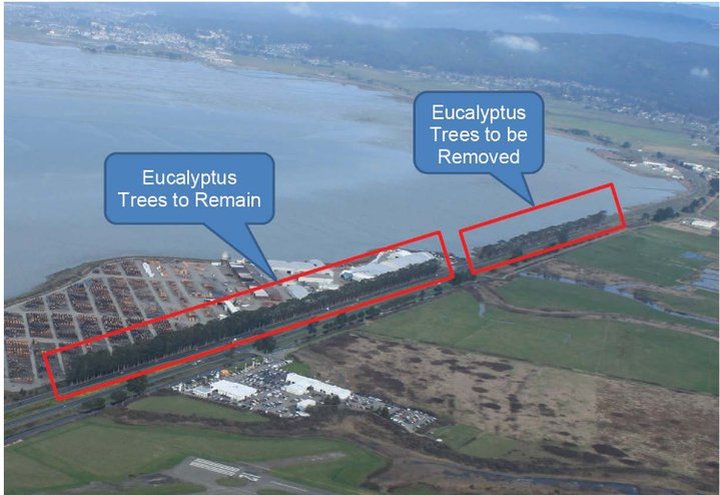
Photo from tree risk assessment report by Dryad, LLC, commissioned by the county.
PREVIOUSLY:
- BYE BYE, EUCALYPTUS? County Staff Recommends Cutting Down Some Trees Along 101 To Complete Humboldt Bay Trail Project; Local Groups Say the Trees Should Stay
- Supervisors Approve Eucalyptus Removal for Bay Trail Project, Though the Trees May Yet be Saved
###
To many locals, the towering row of blue gum eucalyptus along the western shoulder of Highway 101, just north of the California Redwood Company’s former mill site, looks like a majestic local landmark. But to Torrey Young, a registered consulting arborist, these trees look like trouble.
In a presentation to the Humboldt County Board of Supervisors today, Young said the entire stand is in “an advanced state of decline,” showing signs of structural weakness and decay. They have large dead limbs with “weak attachments,” giving them a high potential for causing “significant property damage, injury or death.”
County staff had already recommended removing this northern stretch of trees along the Arcata-Eureka safety corridor — about 40 percent of the Eucalyptus globulus lining that straightaway — to eliminate a safety hazard along the proposed route for the Humboldt Bay Trail.
Here’s an image from the environmental document for that project showing which trees we’re talking about:

But with public outcry over the prospect of tree-removal, the Board of Supervisors in July asked staff to get a professional outside opinion or two. For $12,000 the county’s Department of Public Works contracted the Alameda County firm Dryad, LLC, to prepare a tree risk assessment, which you can read here.
In a letter accompanying the report, Young notes that many years ago these trees were a lot healthier than they are today. They had thicker foliage and provided a pretty good windbreak. Check out this picture of them in 1949:

But over the years the stand has been significantly thinned. Limbs have been lopped off and entire trees removed. And with poor fertility in the soil, bad drainage and high salinity in the groundwater, the trees that remain aren’t doing well. “The small volume of remaining foliage is now concentrated at the tops,” Young notes. “The foliage is declining and branches dying.”
Compare the photo above to the one below, taken in September:

Young only analyzed the northern group of eucalyptus, deliberately ignoring the larger row of trees to the south, which he wasn’t paid to inspect. “I’m very good at not looking at what I’m not supposed to see,” he said, half-jokingly, after First District Supervisor Rex Bohn asked his opinion.

In his presentation to the board, Young noted how sparse many of the trees are, with “decaying wounds” from limb removal and dead branches hanging dozens of feet off the ground. A number of the trees lean in one direction or another, including east over the highway.
After the report, Fourth District Supervisor Virginia Bass said she found Young’s report “pretty compelling” and hadn’t realized just how sparse those trees were. (They reminded her of the plants she neglects in her own office, she said.)
Third District Supervisor Mike Wilson said the report should be turned over to Caltrans, considering the potential traffic hazards, and he noted that the passage of SB 1029, a law changing the mandate of the struggling North Coast Railroad Authority [NCRA], may allow the county more leeway in designing the Bay Trail.
While many people turned out in defense of the trees back in the summer, there were only three public speakers on the topic at today’s meeting. Two argued for keeping the trees while the third spoke in favor of completing the trail.
Second District Supervisor Estelle Fennell, who showed reluctance regarding approve tree removal at earlier meetings, was again hesitant.
“Is there a way we can move forward without mowing down all those beautiful trees that people love?” she asked. She suggested getting a third opinion by hiring another consulting arborist, but Hank Seemann, the county’s deputy director of environmental services, said that would cost tens of thousands of dollars. And if the county were to keep the trees in place it would potentially be committing itself to regular maintenance as well as legal risks.
“It really comes down to what level of risk and liability the board is willing to accept to advance the Bay Trail,” Seemann said.
Board Chair Ryan Sundberg weighed in: “My opinion is we should just move ahead with removing the trees, get the trail going,” he said.
Bohn noted that somewhere between 60 percent and 70 percent of the trees that were once in that section have already been removed, and regarding the trail he said, “Everything comes at a price.”
Fennell told Young his report had been very compelling. “It definitely gave me food for second thought,” she said.
The board voted unanimously to accept the report. Tree removal had already been approved as part of the proposed project back in July, and today the board opted not to retain yet another arborist for a third opinion that may have saved the trees.
Seemann suggested that staff come back to the board in the spring, after having discussions with the NCRA, to look at possible design modifications for the trail. Even with the best-case scenario for a project timeline, he said it will probably be two to three years before construction can begin on this final stretch of the Bay Trail, connecting Eureka and Arcata.
###
DOCUMENTS:
CLICK TO MANAGE